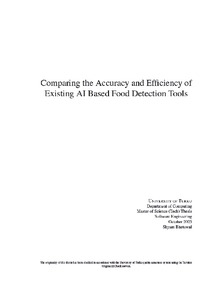Comparing the Accuracy and Efficiency of Existing AI Based Food Detection Tools
Bhetuwal, Shyam Raja (2025-10-30)
Comparing the Accuracy and Efficiency of Existing AI Based Food Detection Tools
Bhetuwal, Shyam Raja
(30.10.2025)
Julkaisu on tekijänoikeussäännösten alainen. Teosta voi lukea ja tulostaa henkilökohtaista käyttöä varten. Käyttö kaupallisiin tarkoituksiin on kielletty.
avoin
Julkaisun pysyvä osoite on:
https://urn.fi/URN:NBN:fi-fe20251031104583
https://urn.fi/URN:NBN:fi-fe20251031104583
Tiivistelmä
The food industry is evolving more rapidly as well as dynamically and the consciousness of consumers on what they are eating is increasing. Current food detection and nutrients analysis platforms exhibit significant variability in accuracy, reliability, user experience and integration capabilities.
There is lack of adequate standardized evaluation and comprehensive comparative analysis, leading to limited insights and guidance for different use cases. This research has aimed to fill this gap by conducting a detailed analysis of the existing AI based models and platforms and integrating sensors and re-correction logic in the application.The accurate detection and evaluation of food items and their nutritional content is critical for applications in healthcare, dietary management and the entire food industry. Reliance on a single data modality like only on the (rgb image) limits the detection for similarly looking food items or the portion sizes. This can reduce the effectiveness of dietary monitoring tools. While general purpose AI models like OpenAI vision has multimodal capabilities even good in food detection shows varying levels of accuracy and efficiency with AI assisted food detection platforms like Calorie Mama AI,FoodSAM, LLaVA LogMeal and other similar platforms.
Despite advances in AI there is a lack of accurate evaluation and comparison of these algorithms, particularly regarding their performance with diverse datasets and real-time images. Additionally, integrating these AI algorithms into a user-friendly interface to process the live images and present data effectively can have significant software engineering challenges. Moreover, while individual algorithms can perform well either in detection, in segmentation or in analysis in the controlled environments, integrating them all into a user-friendly interface for the real application has many additional challenges.
This study has developed an AIoT based integrated system as a solution with camera, scale and APIs from different image detection models to display the most accurate result. Then the accuracies from different sources has been analyzed. The food industry is evolving more rapidly as well as dynamically and the consciousness of consumers on what they are eating is increasing. Current food detection and nutrients analysis platforms exhibit significant variability in accuracy, reliability, user experience and integration capabilities. There is lack of adequate standardized evaluation and comprehensive comparative analysis, leading to limited insights and guidance for different use cases. This research has aimed to fill this gap by conducting a detailed analysis of the existing AI based models and platforms and integrating sensors and re-correction logic in the application.The accurate detection and evaluation of food items and their nutritional content is critical for applications in healthcare, dietary management and the entire food industry. Reliance on a single data modality like only on the (rgb image) limits the detection for similarly looking food items or the portion sizes. This can reduce the effectiveness of dietary monitoring tools. While general purpose AI models like OpenAI vision has multimodal capabilities even good in food detection shows varying levels of accuracy and efficiency with AI assisted food detection platforms like Calorie Mama AI,FoodSAM, LLaVA LogMeal and other similar platforms. Despite advances in AI there is a lack of accurate evaluation and comparison of these algorithms, particularly regarding their performance with diverse datasets and real-time images. Additionally, integrating these AI algorithms into a user-friendly interface to process the live images and present data effectively can have significant software engineering challenges. Moreover, while individual algorithms can perform well either in detection, in segmentation or in analysis in the controlled environments, integrating them all into a user-friendly interface for the real application has many additional challenges. This study has developed an AIoT based integrated system as a solution with camera, scale and APIs from different image detection models to display the most accurate result. Then the accuracies from different sources has been analyzed.
There is lack of adequate standardized evaluation and comprehensive comparative analysis, leading to limited insights and guidance for different use cases. This research has aimed to fill this gap by conducting a detailed analysis of the existing AI based models and platforms and integrating sensors and re-correction logic in the application.The accurate detection and evaluation of food items and their nutritional content is critical for applications in healthcare, dietary management and the entire food industry. Reliance on a single data modality like only on the (rgb image) limits the detection for similarly looking food items or the portion sizes. This can reduce the effectiveness of dietary monitoring tools. While general purpose AI models like OpenAI vision has multimodal capabilities even good in food detection shows varying levels of accuracy and efficiency with AI assisted food detection platforms like Calorie Mama AI,FoodSAM, LLaVA LogMeal and other similar platforms.
Despite advances in AI there is a lack of accurate evaluation and comparison of these algorithms, particularly regarding their performance with diverse datasets and real-time images. Additionally, integrating these AI algorithms into a user-friendly interface to process the live images and present data effectively can have significant software engineering challenges. Moreover, while individual algorithms can perform well either in detection, in segmentation or in analysis in the controlled environments, integrating them all into a user-friendly interface for the real application has many additional challenges.
This study has developed an AIoT based integrated system as a solution with camera, scale and APIs from different image detection models to display the most accurate result. Then the accuracies from different sources has been analyzed.
